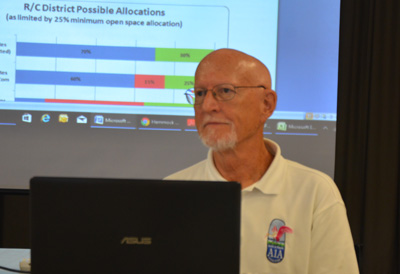
State Road A1A through the Hammock doesn’t look the way it does—rustic, lush, scenic, unique—by accident. County land use policy ensures that it looks that way, unlike most other segments of the road further north and south, where the look is more commercially cavernous and cluttered.
The policy that makes sure it stays that way is complicated. It calls for land development that must remain of “mixed-use, low-intensity” character. To do that, rules require that properties along A1A are proportionately divided between residential uses, which must predominate, some commercial uses, and a certain amount of required open space. The percentages fluctuate and depend on how, say, a commercial development may also include a residential portion, and vice versa. To maintain that balance, developers are sometimes required to trade one designation for another. No one disputes that it’s a hassle and that it can be a difficult formula to apply. But it’s been working. The proof, Hammock advocates say, is in the look of A1A. It has preserved its character rather well.
Some advocates now fear that may be about to change. County government is proposing a change—what it calls “a clarification”—targeting one specific requirement: those commercial developers or users of a commercial segment of a lot who are now required to include a residential component to their development will no longer be required to do so on that particular lot.
“This is a house,” Deputy County Administrator Sally Sherman said, describing the issue from the county’s perspective. “We want to make this part of this house a medical office. But then we’re going to require you to close out that back portion where somebody can stay in that back portion and cook, and stay in that back portion.”
That requirement would end.
The change doesn’t forbid the mix. “You can still put a house there,” Mengel said, without having that house have a commercial requirement. “To me I’m not changing that part.”
But that’s not the issue, says Dennis Clark, who chairs the Scenic A1A Committee, a county advisory panel. “This change affects 483 properties along A1A and pretty much nothing else,” he told county commissioners on Monday. “It also has the power to completely change the character of the Hammock and the Scenic Byway. It will allow creating a business every 75 to 100 feet in an area that is celebrated for its rural old-Florida feel.”
There’s been six residential properties change to commercial properties in the last two years, Clark says. “There’s nothing to prevent that.” The only mechanism in place to serve as a check against such transformation “is the one you’re giving away,” he told Mengel today at a meeting of Scenic A1A at the Hammock Community Center.

While that’s not in dispute, it also somewhat muddies the concern at the heart of Clark’s analysis: it’s the character of the Hammock along A1A that may be in jeopardy if the county’s interpretation prevails.
Sherman addressed that by saying that if the Hammock fears its portion of A1A will one day look like Orlando’s International Drive, “that’s not going to happen.”
“We’re totally, totally in sync with making sure that the character of A1A remains,” Sherman said, stressing the county’s commitment that even with coming developments, the character of the road is preserved.
Mengel said the goal is still to ensure a mix, even if the residential component is withdrawn. “The policy is still intact,” he said, with commercial developments still being required to go through the special-exception hurdle to get approved, though that’s where the issue comes down to: it’s a matter of interpretation. The county is interpreting it one way. Some Hammock residents represented by a panel such as Scenic A1A are interpreting it differently.
Another way of understanding the county’s analysis is this: the land-use mix was previously interpreted as applying lot by lot, so that the commercial-residential mix had to be reflected down to a quarter-acre lot. That’s unrealistic and untenable for developers, in the county’s view. A more fair application of the rule, in its view, is to apply the mixed-use language to the Barrier Island zone as a whole, so that, given the preponderance of residential uses, the commercial mix along A1A has room to grow without saddling it with yet more residential requirements.
“Every half-acre lot along A1A is going to be a commercial business?” a member of the panel asked. “That’s a very dangerous thing.” (“We also have to contend with the fact that the overbuilding of condos on A1A,” Carol Scott, another member of the panel, noted, reviving another issue that’s occasionally bedeviled the barrier island under the cover of meeting mixed-use rules.)
But the danger, the county argues, is buffered by every commercial developer having to go through the special-exception process—a process. That process Clark said, “has no teeth.” He added: despite those restrictions, “the number of businesses can expand without any control.”
“I’ve been part of special exceptions that get denied, including in the Hammock,” Jay Livingston, a land-use attorney, said at today’s meeting, lending his voice in support of the county’s position. He went so far as to suggest that anyone building a home would have to include a commercial component to, if the language of the policy was applied strictly. (That’s actually never happened, even if “if we look at it in the strictest sense of the word, yeah, we should,” Sherman said.) Livingston primarily represents commercial developers, and is representing some on A1A now. He says there are built-in limits on commercial developments that will preserve the character of the Hammock, even if the residential component is removed.
The change, which Clark considers to be very substantial, was slated to be almost routinely approved by the County Commission Monday. It had gone before the county’s planning board previously. Clark asked the board to delay the matter to give him and his committee time to study it. The board refused. But Clark was more successful on Monday: the County Commission delayed approval.
Which brought county officials and the Scenic A1A group face to face at this morning’s meeting. (The meeting started at 9 a.m. Commissioner Greg Hansen, whose district includes the Hammock, joined the discussion at 10:30, after his appearance on this morning’s Free For All Friday radio show on WNZF.) But in the end, the session was not so much a meeting of the minds as a chance for the various sides to make their case. The county did not propose a change in its approach so much as explain why its approach should not be worrisome to the Hammock.
“So basically we feel powerless is what I’m saying, and unless we address this we’re still going to be powerless,” Clark said, asking again to have the item before the commission delayed until it is addressed directly with the commissioners.
He did not win that commitment to delay the measure before the County Commission. Sherman suggested Clark and the panel could submit a proposal through the 2018 review of the county’s comprehensive plan. And for all of Sherman’s reassurances (she says she doesn’t think that the county’s interpretation of the rule “is going to devastate or create a huge change in this community”),
Clark held firm: “I disagree that it’s that simple. There are other unintended consequences that can happen,” he said. He proposed the equivalent of a mitigation bank where commercial developers can “buy” commercial rights, as one possibility to protect the area from overdevelopment. He will seek to delay the proposed measure by addressing the commission directly, once again, at its first September meeting.
The county is making its immovable position clear. “I’m not going to be recommending anything where we’re constantly put in a position to be sued because I’ve violated somebody’s property rights,” Sherman said.
Hansen, who spoke toward the end of the discussion , which by then was well in its second hour, gave a good idea of where the issue is headed. “If we do this there’s absolutely no change. No change. So I don’t understand the argument, why you’re against this.” Whether a developer has to have an apartment on the premises or not doesn’t make a difference: the developer will still open a store, a restaurant or a different sort of business. “So what does it make a difference whether he has an apartment on it or not? So my vote, and I have to be honest about this, I’m going to vote to do this.”




























USA Lover says
The way this county makes businesses jump through hoops and “permits” them to death,I don’t think there’s anything to worry about.
GrGrMommy says
Already know they don’t listen to the voters, or they listen and just ignore our wishes.
I remember as a child, coming to Daytona. As I aged and returned, the beautiful beach started to grow forests of high rises and they are still growing. Power and money always win. I’m old now, glad I won’t be around to see our beautiful part of A1A disappear
Old Lady says
Leave the Hammock alone, send those “progressives” bak where tthey came from.
Paula says
First the mini-hotels come to communities zoned single-family, and the investors insist they are residential; now we are going to have an A1A that could potentially be transformed. Horrible news.
ASF says
Just think of all the Meth labs whose business might be disrupted by new business coming in!
Mark101 says
Just leave the Hammock and A1A alone.
Anonymous says
I see a room of “foot in the gravers” still holding back flagler county from having jobs-always avoiding commerce and using scenic landscape as an exuse–at every attempt…
if it were up to the people that are on that board flagler county would have 1 business-walmart.
Had enough? says
What is conveniently ignored by the County staff is that the City of Palm Coast is slated to provide water and sewer from the Hammock Dunes bridge to Marineland. Once water and sewer is available, you will have Jacksonville/Fort Lauderdale/Miami intensity development on the barrier island.
snapperhead says
I think a strip mall along that stretch with a McDonalds, liquor store, mattress store , bank and a pot dispensary would be a nice addition.
Anonymous says
The Hammock is no different than Flagler Beach…..the people can live there and there is room and reason for businesses as the property owners aren’t the only ones served by the area. The beaches and road ways belong to all of us. Time to stop acting like because you live in the Hammock you hold the keys to access.
John dolan says
Like Ormond Beach the rich boys always win. The golden rule.
Sw says
One thing for certain, change for better or worse
Kevin says
At the very least replace the residential requirement with an open space requirement of an equal square footage. There must be continued vigilance in defending the sense of place that has been protected by wise regulations. Nothing worthwhile is easy. If the process is complex but the results are clearly working then the complexity is worthwhile. We don’t need more drive-through dumpster fast food restaurants and junk for a dollar stores, there are already too many American landscapes blighted by this sort of “development”. What attracts tourists and residents alike is the iconic natural appeal of A1A. Open Space Makes The Difference!
Brian Smith says
Expect A1A to be called Condo Canyon in the future..